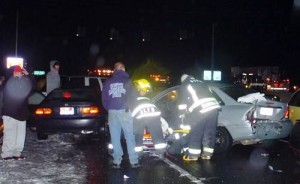Car crashes are the leading cause of death among teen drivers, young drivers having three times the rate of fatal crashes as all motorists. And the accident rate routinely spikes 26% during what the AAA is calling the “100 Deadliest Days” of the year.
But parents can play a big role, the organization is stressing, pointing to studies that show accident rates are measurably lower when teens have limits set on their driving privileges.
“Parents are instrumental and play a significant role helping their teen be a safer driver,” said John Pecchio, a traffic safety consultant with the AAA. “During the summer months, teens are more care-free and excited to have the freedom to drive around. So it’s imperative parents help keep safety top of mind.”
There are more drivers on the road, in general, between the Memorial Day and Labor Day holidays, which only increases the risk to young, inexperienced drivers. And not only are teens more likely to be killed while behind the wheel, but they are also more likely to cause the death of others, whether their passengers, pedestrians, or occupants of another vehicle.
In fact, the AAA said that each person who rides along with a 16- or 17-year-old driver is likely to lead to an “exponential” increase in the risk of a crash. Add one passenger under 21 and the risk of being killed jumps 44%. With two, it doubles, and it quadruples if there are three or more passengers onboard under 21. That is a major reason why a number of states now issue graduated, first-time licenses that restrict the number of youths that a teen driver can travel with.
(Pregnancy linked to higher car crash risk. Click Herefor more.)
Summer break is, on the whole, a dangerous time for teen drivers, warns AAA, but it has also noted in prior studies that seven of the 10 deadliest days for young motorists occur during the warm season.
In all, an average of 260 teens are killed in crashes each month during the summer season, the highest rate of the year, and 25% higher than during other months, said AAA.
A separate report by the National Highway Traffic Safety Administration last week listed the overall cost of motor vehicle crashes at nearly $900 billion annually in the U.S. The report noted that speeding, driving under the influence of alcohol and distracted driving are the three most costly – and deadly – driving behaviors. Separate research has shown they all play a role in teen fatalities.
(Click Here for more on that NHTSA study.)
AAA data underscores the particular risk of distracted driving, noting that drivers between the ages of 17 and 26 talk at least an hour a day on their cellphones and send 80 texts daily. A full 94% keep their phones on while driving. Meanwhile, the vast majority don’t believe distracted driving puts them at risk.
The travel and highway organization issued suggested guidelines parents can follow to keep their teen drivers safe:
- Restrict driving, especially when there’s no specific purpose for a trip. The teen crash rate is highest during the first year of driving, so parents should allow travel only with permission;
- Limit the number of teens who can travel with a young motorist. That is likely to reduce the number of distractions – and leave it less likely a teen driver will take risky behaviors;
- A teen driver is twice as likely to have a deadly crash at night, so restrict driving after dark unless a young driver is accompanied by an adult;
- Practice driving with a teen even after they are licensed. That can help a young motorist understand what to do in a complex situation;
- Be a role model. Other studies have shown that teens tend to emulate the driving behavior of their parents.
It also can help to put in writing an agreement spelling out clear rules about driving behaviors. A model agreement can be found at TeenDriving.AAA.com.
Several automakers now allow parents to set limits on driving behaviors, such as with the Ford MyKey system that not only limits the radio volume but sets a top speed a teen can drive at.
A number of aftermarket systems are now available, meanwhile, that can be used to track where teen drivers have wandered off to, allowing a parent to create a “geo-fence” limiting how long and how far away a teen can drive.
(Death toll from GM ignition switch defect likely to rise. Click Here for the latest.)


